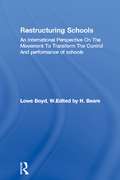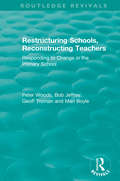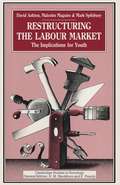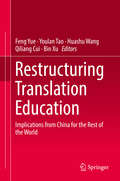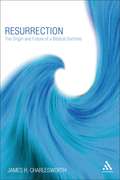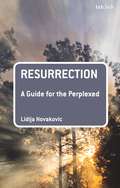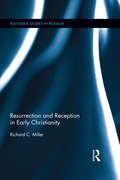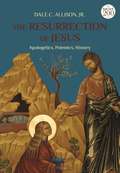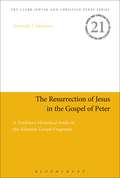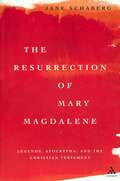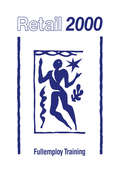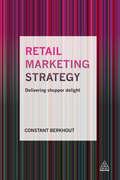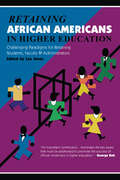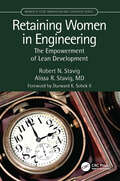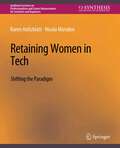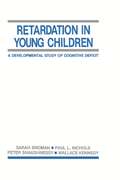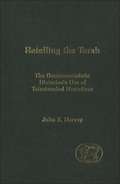- Table View
- List View
Restructuring Schools: An International Perspective On The Movement To Transform The Control And performance of schools
by W. Lowe BoydEducation reform has become part of a political imperative in a number of developed countries around the world. The simultaneous movement to reform schooling and the administrative structures which deliver educational services therefore needs to be studied in order to lay bare its fundamental assumptions. This movement has been labelled "restructuring" and "reform", although the words carry different meanings in different countries.; The authors question why this reconstruction occurred at the same time in different places. What common themes are emerging in the restructuring movement? And in the 1990s, where will the movement lead schooling and what essential changes will it effect? They explore these questions by examining developments in the USA, Canada, the UK, Australia, New Zealand and Japan.
Restructuring Schools, Reconstructing Teachers: Responding to Change in the Primary School (Routledge Revivals)
by Peter Woods Bob Jeffrey Mari Boyle Geoff TromanDrawing on wide ranging research this book, originally published in 1997, explores how the policy changes of previous years were affecting primary teachers and their work at the time. Within the context of worldwide restructuring, the thoughts, feelings and activities of teachers in their daily work are examined. The core argument is that what used to be a complex but fulfilling job distinguished by professional dilemmas, which are amenable to professional skill, had become increasingly marked by tension and constraint, which frustrates teacher creativity. While some teachers found new opportunities in the ‘new’ primary school, many used strategical and micro-political activity in order to cope, while others fell victim to stress and burnout. The authors argue that teachers’ own active involvement in policy change is required if their creative potential is to be realized. The book will still be of interest to teachers in primary schools, researchers and policy makers.
Restructuring Schools, Reconstructing Teachers: Responding to Change in the Primary School (Routledge Revivals)
by Peter Woods Bob Jeffrey Mari Boyle Geoff TromanDrawing on wide ranging research this book, originally published in 1997, explores how the policy changes of previous years were affecting primary teachers and their work at the time. Within the context of worldwide restructuring, the thoughts, feelings and activities of teachers in their daily work are examined. The core argument is that what used to be a complex but fulfilling job distinguished by professional dilemmas, which are amenable to professional skill, had become increasingly marked by tension and constraint, which frustrates teacher creativity. While some teachers found new opportunities in the ‘new’ primary school, many used strategical and micro-political activity in order to cope, while others fell victim to stress and burnout. The authors argue that teachers’ own active involvement in policy change is required if their creative potential is to be realized. The book will still be of interest to teachers in primary schools, researchers and policy makers.
Restructuring the Labour Market: The Implications for Youth (Cambridge Studies in Sociology)
by D. Ashton M. Maguire M. SpilsburyThis book represents an advance in our knowledge of the labour market. For the first time it combines the analysis of both quantitative and qualitative data to produce an explanation of the main changes which have transformed the labour market during the recession. For the first time it demonstrates the segmented character of the youth labour market and the significance of the local labour markets. The result is a substantial contribution to labour market segmentation theory and to the analysis of social policy in this field.
Restructuring Translation Education: Implications from China for the Rest of the World
by Feng Yue Youlan Tao Huashu Wang Qiliang Cui Bin XuThis book offers data-based insights into the problems of translation education and their causes in the context of localization and globalization in the era of big data. By examining language services around the globe, illustrating applications of big-data technology and their future development, and describing crowdsourcing and online collaborative translations, speech-to-speech translation and cloud-based translation, it makes readers aware of the important changes taking place in the professional translation market and consequently recognize the insufficiency of translation education and the need for it to be restructured accordingly. Furthermore, the book includes data-based analyses of translation education problems, such as teaching philosophy, curriculum design and faculty development of both undergraduate and postgraduate education in China. More importantly, it proposes solutions that have already been successful in experiments in a number of universities in China for other institutions of higher education to imitate in restructuring translation education. The discussion is of interest for current and future translation policy makers, translation educators, translators and learners.
Resurrection: The Origin and Future of a Biblical Doctrine
by James H. CharlesworthResurrection is the central feature of the New Testament gospels and lies at the center of many of Paul's letters as well. In addition, the doctrine of the resurrection lies at the core of the Christian church's faith. The essays in this stunning collection explore the idea of resurrection as the idea appears not only in the New Testament texts but also in the Dead Sea Scrolls, the pseudepigraphal Testaments of the Twelve Patriarchs, and in contemporary theology. Charlesworth asks where the concept of resurrection appears and the ways we know it, and he also examines the concept of resurrection in the Dead Sea Scrolls and the New Testament. Casey Elledge explores the earliest evidence we have for a notion of a resurrection of the dead and investigates the hope for Israel in Judaism and Christianity found in the Testaments. Crenshaw looks at the Hebrew Bible's ideas of resurrection, and Hendrikus Boers examines the meaning of Christ's resurrections in Paul's writings. W. Waite Willis explores a theology of resurrection.
Resurrection: A Guide for the Perplexed (Guides for the Perplexed)
by Lidija NovakovicThis volume examines what the followers of Jesus meant when they declared that he was raised from the dead. This claim, which lies at the core of Christian faith, is one of the most controversial topics in Christianity. Jesus' resurrection has no analogy in human history. Although many 1st-century Jews expected the resurrection of the dead at the end of time, the Christian claim that this had already happened to one individual within the realm of history was unprecedented. Moreover, an affirmation of Jesus' bodily resurrection contradicts the known laws of nature. Additional difficulty comes from the nature of the available evidence. The New Testament sources not only mirror the worldview of ancient authors but also differ with regard to who saw him alive, what was the nature of his risen body, and whether the empty tomb was a widespread knowledge or an assumption based on prior beliefs. Novakovic presents all these issues in a clear and methodical way. She examines the literary sources and addresses various questions related to historical investigations of Jesus' resurrection.
Resurrection: The Role Of The Old Testament In The Early Christian Interpretations Of Jesus' Resurrection (Guides for the Perplexed #12)
by Lidija NovakovicThis volume examines what the followers of Jesus meant when they declared that he was raised from the dead. This claim, which lies at the core of Christian faith, is one of the most controversial topics in Christianity. Jesus' resurrection has no analogy in human history. Although many 1st-century Jews expected the resurrection of the dead at the end of time, the Christian claim that this had already happened to one individual within the realm of history was unprecedented. Moreover, an affirmation of Jesus' bodily resurrection contradicts the known laws of nature. Additional difficulty comes from the nature of the available evidence. The New Testament sources not only mirror the worldview of ancient authors but also differ with regard to who saw him alive, what was the nature of his risen body, and whether the empty tomb was a widespread knowledge or an assumption based on prior beliefs. Novakovic presents all these issues in a clear and methodical way. She examines the literary sources and addresses various questions related to historical investigations of Jesus' resurrection.
The Resurrection
by Geza VermesThe story of Christ’s crucifixion and subsequent resurrection is the rock of faith on which Christianity is founded. But on what evidence is the most miraculous phenomenon in religious history based? World-famous Biblical scholar Geza Vermes has studied all the evidence that still remains, over two thousand years after Jesus Christ was reported to have risen from the dead. Examining the Jewish Bible, the New Testament and other accounts left to us, as well as contemporary attitudes to the afterlife, he takes us through each episode with a historian’s focus: the crucifixion, the treatment of the body, the statements of the women who found the empty tomb, and the visions of Christ by his disciples. Unravelling the true meaning conveyed in the Gospels, the Acts and St Paul, Vermes shines new light on the developing faith in the risen Christ among the first followers of Jesus.
Resurrection and Reception in Early Christianity (Routledge Studies in Religion)
by Richard C. MillerThis book offers an original interpretation of the origin and early reception of the most fundamental claim of Christianity: Jesus’ resurrection. Richard Miller contends that the earliest Christians would not have considered the New Testament accounts of Jesus’ resurrection to be literal or historical, but instead would have recognized this narrative as an instance of the trope of divine translation, common within the Hellenistic and Roman mythic traditions. Given this framework, Miller argues, early Christians would have understood the resurrection story as fictitious rather than historical in nature. By drawing connections between the Gospels and ancient Greek and Roman literature, Miller makes the case that the narratives of the resurrection and ascension of Christ applied extensive and unmistakable structural and symbolic language common to Mediterranean "translation fables," stock story patterns derived particularly from the archetypal myths of Heracles and Romulus. In the course of his argument, the author applies a critical lens to the referential and mimetic nature of the Gospel stories, and suggests that adapting the "translation fable" trope to accounts of Jesus’ resurrection functioned to exalt him to the level of the heroes, demigods, and emperors of the Hellenistic and Roman world. Miller’s contentions have significant implications for New Testament scholarship and will provoke discussion among scholars of early Christianity and Classical studies.
The Resurrection of Jesus: Apologetics, Polemics, History
by Dale C. Allison, Jr.The earliest traditions around the narrative of Jesus' resurrection are considered in this landmark work by Dale C. Allison, Jr, drawing together the fruits of his decades of research into this issue at the very core of Christian identity. Allison returns to the ancient sources and earliest traditions, charting them alongside the development of faith in the resurrection in the early church and throughout Christian history. Beginning with historical-critical methodology that examines the empty tomb narratives and early confessions, Allison moves on to consider the resurrection in parallel with other traditions and stories, including Tibetan accounts of saintly figures being assumed into the light, in the chapter “Rainbow Body”. Finally, Allison considers what might be said by way of results or conclusions on the topic of resurrection, offering perspectives from both apologetic and sceptical viewpoints. In his final section of “modest results” he considers scholarly approaches to the resurrection in light of human experience, adding fresh nuance to a debate that has often been characterised in overly simplistic terms of “it happened” or “it didn't”.
The Resurrection of Jesus: Apologetics, Polemics, History
by Dale C. Allison, Jr.The earliest traditions around the narrative of Jesus' resurrection are considered in this landmark work by Dale C. Allison, Jr, drawing together the fruits of his decades of research into this issue at the very core of Christian identity. Allison returns to the ancient sources and earliest traditions, charting them alongside the development of faith in the resurrection in the early church and throughout Christian history. Beginning with historical-critical methodology that examines the empty tomb narratives and early confessions, Allison moves on to consider the resurrection in parallel with other traditions and stories, including Tibetan accounts of saintly figures being assumed into the light, in the chapter “Rainbow Body”. Finally, Allison considers what might be said by way of results or conclusions on the topic of resurrection, offering perspectives from both apologetic and sceptical viewpoints. In his final section of “modest results” he considers scholarly approaches to the resurrection in light of human experience, adding fresh nuance to a debate that has often been characterised in overly simplistic terms of “it happened” or “it didn't”.
The Resurrection of Jesus in the Gospel of Peter: A Tradition-Historical Study of the Akhmîm Gospel Fragment (Jewish and Christian Texts #21)
by Jeremiah J. JohnstonAll four canonical gospels identify the resurrection of Jesus, yet none detail the exact moment of its happening. The absence of this narrative detail was hotly contested in the second century, when critics derided a resurrection account without credible witness. Thus, the discovery of the Akhmim fragment at the end of the 19th century, which purports to provide exactly that detail, is a huge and surprisingly under-utilised addition to Biblical scholarship of the Apocryphal gospels. Johnston examines both the impact of this discovery on the scholarship at the time, and argues for the dating of the fragment to the second century AD. He identifies shared characteristics with other documents from this period, including a rise in anti-semitic feeling, and developments in concepts of the afterlife, and makes a claim for this fragment being the text that aided the development of these movements.The Second Century was the key time in which the non-canonical Biblical texts were established. It was also the era in which theologies which would become 'orthodox' in the third century were penned and defined. The significance, then, of dating the Akhmim fragment to the second century AD is huge. This work will be of great use to scholars of Second Temple Judaism, and those with an interest in the creation of the ideas that surround scholarship of the Bible.
The Resurrection of Mary Magdalene: Legends, Apocrypha, and the Christian Testament
by Jane SchabergThe controversy surrounding Dan Brown's novel The Da Vinci Code has intensified interest in Mary Magdalene and Jane Schaberg provides an authoritative source for a deeper understanding and re-assessment of this popular figure. Within a progressive feminist framework, The Resurrection of Mary Magdalene approaches Christian Testament sources through analysis of legend, archaeology, and gnostic/apocryphal traditions. This is the story of the suppression and distortion of a powerful woman leader - Schaberg presents Mary Magdalene as successor to Jesus in a challenging alternative to the Petrine primacy.
Retail 2000
by NA NAThis pack provides a comprehensive training scheme to be used by Fullemploy, the training scheme for retail and distributive trades. It gives a broad based training for the retail industry which is applicable to the increasing range and variety of outlets in existence.
Retail Marketing Strategy: Delivering Shopper Delight
by Constant BerkhoutBasing shopper marketing strategy on customer insights is what differentiates market leading retail brands from weaker competitors. Many retail organizations lack business development and strategic departments that collect experiences, set benchmarks and create models and manuals. Retail Marketing Strategy makes the information available to drive new ways of thinking and make retail practice more agile for everyone. Outlining the five key capabilities required for retail excellence, namely in-store execution; organizational development; fact-driven decision making; multi-channel operations, and understanding customers, Retail Marketing Strategy answers some of the most difficult questions in retail including how to innovate to develop new ways to interact with customers across multiple channels, and how to replicate online success stories from other sectors. Practical steps are put forward for collating and interpreting the data generated in shopper activity, helping to make sense of trends and build effective strategy. Guidance is based throughout on neuromarketing research, providing a clear framework for building in experiential elements such as scent or music into the retail environment to really engage with consumers on an emotional level.If you are a marketing, branding or supply chain professional working in retail seeking straightforward and research-driven techniques for building lasting customer loyalty, or you are responsible for driving retail strategy in your organization, let Retail Marketing Strategy be your guide.
Retail Marketing Strategy: Delivering Shopper Delight
by Constant BerkhoutBasing shopper marketing strategy on customer insights is what differentiates market leading retail brands from weaker competitors. Many retail organizations lack business development and strategic departments that collect experiences, set benchmarks and create models and manuals. Retail Marketing Strategy makes the information available to drive new ways of thinking and make retail practice more agile for everyone. Outlining the five key capabilities required for retail excellence, namely in-store execution; organizational development; fact-driven decision making; multi-channel operations, and understanding customers, Retail Marketing Strategy answers some of the most difficult questions in retail including how to innovate to develop new ways to interact with customers across multiple channels, and how to replicate online success stories from other sectors. Practical steps are put forward for collating and interpreting the data generated in shopper activity, helping to make sense of trends and build effective strategy. Guidance is based throughout on neuromarketing research, providing a clear framework for building in experiential elements such as scent or music into the retail environment to really engage with consumers on an emotional level.If you are a marketing, branding or supply chain professional working in retail seeking straightforward and research-driven techniques for building lasting customer loyalty, or you are responsible for driving retail strategy in your organization, let Retail Marketing Strategy be your guide.
Retaining African Americans in Higher Education: Challenging Paradigms for Retaining Students, Faculty and Administrators
by Lee JonesRetention of African Americans on campus is a burning issue for the black community, and a moral and financial one for predominantly white institutions of higher education. This book offers fresh insights and new strategies developed by fifteen scholars concerned by the new climate in which affirmative action is being challenged and eliminated.This is the first book devoted specifically to retention of African Americans in higher education, and is unique in addressing the distinct but inter-related concerns of all three affected constituencies: students, faculty and administrators. Each is considered in a separate section.The student section shifts attention from, to paraphrase McNairy, "fixing the student" to focussing on higher education's need to examine and, where appropriate, revise policies, curriculum, support services and campus climate. Responding to the new agenda shaped by the opponents of affirmative action, but rejecting the defensive "x percent solutions" espoused by its proponents, this book puts forward new solutions that will provoke debate. Section II begins with a survey of the literature on African American administrators, and presents a Delphi study of twelve administrators to provide an understanding of pathways and barriers to success. The contributors then consider the importance of developing community support and creating alliances, the role of mentoring, and the setting of clear expectations between the individual and the institution.Starting with the recognition that African Americans represent less than five percent of full-time faculty, the chapters in the final section examine the effects of the dismantling of affirmative action, the consequences of faculty salaries trailing more lucrative non-academic employment, the declining enrollment of students of color, the politics of promotion and tenure, and issues of identity and culture. The book concludes by stressing the roles that parents, faculty and administrators must play to empower African American students to take responsibility for their own academic performance.This is a compelling, controversial and constructive contribution to an issue of national importance.
Retaining African Americans in Higher Education: Challenging Paradigms for Retaining Students, Faculty and Administrators
Retention of African Americans on campus is a burning issue for the black community, and a moral and financial one for predominantly white institutions of higher education. This book offers fresh insights and new strategies developed by fifteen scholars concerned by the new climate in which affirmative action is being challenged and eliminated.This is the first book devoted specifically to retention of African Americans in higher education, and is unique in addressing the distinct but inter-related concerns of all three affected constituencies: students, faculty and administrators. Each is considered in a separate section.The student section shifts attention from, to paraphrase McNairy, "fixing the student" to focussing on higher education's need to examine and, where appropriate, revise policies, curriculum, support services and campus climate. Responding to the new agenda shaped by the opponents of affirmative action, but rejecting the defensive "x percent solutions" espoused by its proponents, this book puts forward new solutions that will provoke debate. Section II begins with a survey of the literature on African American administrators, and presents a Delphi study of twelve administrators to provide an understanding of pathways and barriers to success. The contributors then consider the importance of developing community support and creating alliances, the role of mentoring, and the setting of clear expectations between the individual and the institution.Starting with the recognition that African Americans represent less than five percent of full-time faculty, the chapters in the final section examine the effects of the dismantling of affirmative action, the consequences of faculty salaries trailing more lucrative non-academic employment, the declining enrollment of students of color, the politics of promotion and tenure, and issues of identity and culture. The book concludes by stressing the roles that parents, faculty and administrators must play to empower African American students to take responsibility for their own academic performance.This is a compelling, controversial and constructive contribution to an issue of national importance.
Retaining Women in Engineering: The Empowerment of Lean Development (Women of STEM)
by Robert N. Stavig Alissa R. StavigDiversity drives better business results; however, despite decades of effort, women make up only 15% of engineers. Retaining Women in Engineering: The Empowerment of Lean Development approaches the problem of women leaving engineering from a systems-level perspective to change the way engineering is done and level the playing field between men and women. This book utilizes the six principles of Lean Development and draws from the learnings of the field of medicine, recognizing that access to a vast amount of written knowledge is an important part of a physician’s learning process. Using these principles, the book provides leaders with concrete strategies and methods to change the way engineering is done and learning occurs. Integrated within the book are "gray box stories" which describe two different worlds that engineers work in: that of traditional development and that of Lean Development. These stories underscore the way that the gender confidence gap, bias, and stereotypes affect a female engineer’s career. Additionally, the book highlights how the methods of Lean Development strengthen an individual’s ability to control their learning and career, and a leader’s ability to coach others more effectively. Ultimately, this results in more capable teams. Furthermore, not unlike the marine chronometer (a clock) which solved the centuries old challenge of establishing the longitudinal location for a ship at sea, this book finds the "clock" that levels the playing field between men and women. This book will help leaders at every level within an engineering firm, as well as women engineers and managers who want to grow to their full potential, and others who care about gender equity.
Retaining Women in Engineering: The Empowerment of Lean Development (Women of STEM)
by Robert N. Stavig Alissa R. StavigDiversity drives better business results; however, despite decades of effort, women make up only 15% of engineers. Retaining Women in Engineering: The Empowerment of Lean Development approaches the problem of women leaving engineering from a systems-level perspective to change the way engineering is done and level the playing field between men and women. This book utilizes the six principles of Lean Development and draws from the learnings of the field of medicine, recognizing that access to a vast amount of written knowledge is an important part of a physician’s learning process. Using these principles, the book provides leaders with concrete strategies and methods to change the way engineering is done and learning occurs. Integrated within the book are "gray box stories" which describe two different worlds that engineers work in: that of traditional development and that of Lean Development. These stories underscore the way that the gender confidence gap, bias, and stereotypes affect a female engineer’s career. Additionally, the book highlights how the methods of Lean Development strengthen an individual’s ability to control their learning and career, and a leader’s ability to coach others more effectively. Ultimately, this results in more capable teams. Furthermore, not unlike the marine chronometer (a clock) which solved the centuries old challenge of establishing the longitudinal location for a ship at sea, this book finds the "clock" that levels the playing field between men and women. This book will help leaders at every level within an engineering firm, as well as women engineers and managers who want to grow to their full potential, and others who care about gender equity.
Retaining Women in Tech: Shifting the Paradigm (Synthesis Lectures on Professionalism and Career Advancement for Scientists and Engineers)
by Holtzblatt Karen Marsden NicolaFor over 40 years, the tech industry has been working to attract more women. Yet, women continue to be underrepresented in technology jobs compared to other professions. Worse, once hired, women leave the field mid-career twice as often as men. In 2013, Karen Holtzblatt launched The Women in Tech Retention Project at WITops.org, dedicated to understanding what helps women in tech thrive. In 2014, Nicola Marsden joined the effort, bringing her extensive knowledge and research on gender and bias for women in tech. Together with worldwide volunteers, this research identified what helps women thrive and practical interventions to improve women’s experience at work. In this book, we share women’s stories, our research, relevant literature, and our perspective on making change to help retain women. All the research and solutions we share are based on deep research and user-centered ideation techniques. Part I describes the @Work Experience Framework and the six key factors that help women thrive: a dynamic valuing team; stimulating projects; the push into challenges with support; local role models; nonjudgmental flexibility to manage home/work balance; and developing personal power. Employees thinking of leaving their job have significantly lower scores on these factors showing their importance for retention. Part II describes tested interventions that redesign work practices to better support women, diverse teams, and all team members. We chose these interventions guided by data from over 1,000 people from multiple genders, ethnicities, family situations, and countries. Interventions target key processes in tech: onboarding new hires; group critique meetings; and Scrum. Interventions also address managing interpersonal dynamics to increase valuing and decrease devaluing behaviors and techniques for teams to define, monitor, and continuously improve their culture. We conclude by describing our principles for redesigning processes with an eye toward issues important to women and diverse teams.
Retardation in Young Children: A Developmental Study of Cognitive Deficit
by Sarah H. Broman Paul L. Nichols Peter Shaughnessy Wallace KennedyResults of the Collaborative Perinatal Project report disclose the risk factors for mental retardation found in children examined from the prenatal period to age seven. Both biological and social risk factors are analyzed for both severe and mild cognitive deficits. The authors of this volume investigated the etiologies of the neurological subgroups of the retarded and reveal, through comparisons with non-retarded groups, important population factors related to normal cognitive development.
Retardation in Young Children: A Developmental Study of Cognitive Deficit
by Sarah H. Broman Paul L. Nichols Peter Shaughnessy Wallace KennedyResults of the Collaborative Perinatal Project report disclose the risk factors for mental retardation found in children examined from the prenatal period to age seven. Both biological and social risk factors are analyzed for both severe and mild cognitive deficits. The authors of this volume investigated the etiologies of the neurological subgroups of the retarded and reveal, through comparisons with non-retarded groups, important population factors related to normal cognitive development.
Retelling the Torah: The Deuternonmistic Historian's Use of Tetrateuchal Narratives (The Library of Hebrew Bible/Old Testament Studies)
by John E. HarveyThe Deuteronomistic Historian patterned more than four dozen of his narratives after those in Genesis-Numbers. The stories that make up Genesis-Numbers were indelibly impressed on the Deuteronomistic Historian's mind, to such an extent that in Deuteronomy-Kings he tells the stories of the nation through the lens of Genesis-Numbers.John Harvey discusses the eight criteria which may be used as evidence that the given stories in Deuteronomy-Kings were based on those in Genesis-Numbers. Unified accounts in the Deuteronomistic History, for instance, often share striking parallels with two or more redactional layers of their corresponding accounts in Genesis-Numbers, showing that the given accounts in the Deuteronomistic History were written after the corresponding accounts in Genesis-Numbers had been written. Furthermore, the Deuteronomistic Historian calls the reader's attention to accounts in Genesis-Numbers by explicitly citing and referring to them, by using personal names, and by drawing thematic and verbal parallels. Retelling the Torah, the first book to focus on these parallel narratives, contains far-reaching implications for Hebrew Bible scholarship.
